- Home
- Garden Wildlife
- Insects
- True flies
- Bibionid flies
Bibionid flies
Flies in the family Bibionidae, sometimes called March flies, are mainly seen in late spring and are often associated with lawns and other grassy places.
Species in Britain and Ireland
There are 18 species of bibionid flies in Britain and Ireland, in two genera, with 14 Bibio species and four Dilophus species. The latter are 5-6 mm long as adults and are sometimes called fever flies. Dilophus febrilis is a very common species. Most Bibio species lack common names, but Bibio marci is known as St Mark’s fly, because ite annual emergence tends to conicide with St Mark's Day on 25th April. This is 10-12mm long and one of the larger species. Most Bibio species are 6-8mm long, including Bibio johannis and B. hortulanus, which are associated with lawns.
Male St Mark’s fly Bibio marci in flight, showing typical dangling legs. Right: Bibio hortulanus female
Biology
Bibionid flies are mainly black in colour but sometimes have reddish brown legs or abdomens. The males have particularly large eyes that cover most of the head. The hind legs are longer than the other two pairs and dangle down when the insect is in flight. They fly relatively slowly and male St Marc's fly sometimes appear in mating swarms in grassy places on sunny days in April-May.
The adult flies often visit flowers where they presumably feed on nectar and pollen. The larvae live near the soil surface where they feed on plant roots and decaying plant material. Sometimes large aggregations of the greyish brown larvae are found when accumulations of dead leaves are being raked up in the autumn. Bibionid larvae are superficially similar in appearance to leatherjackets, which are the larvae of crane flies. Unlike leatherjackets, bibionid larvae have distinct head capsules and small spines projecting from the body segments.
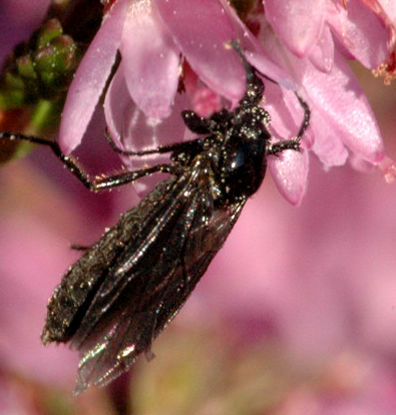
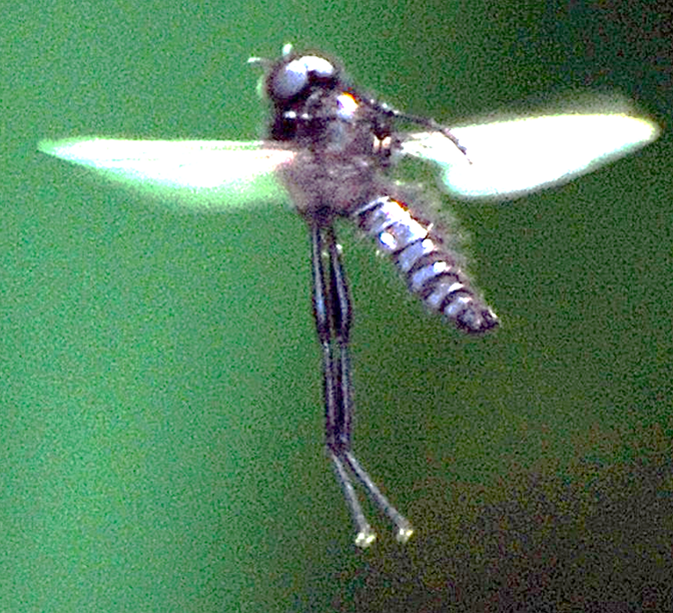
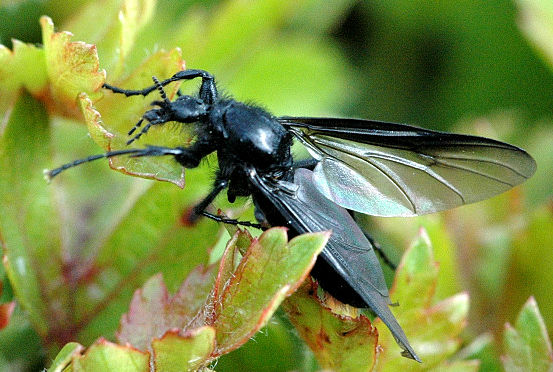
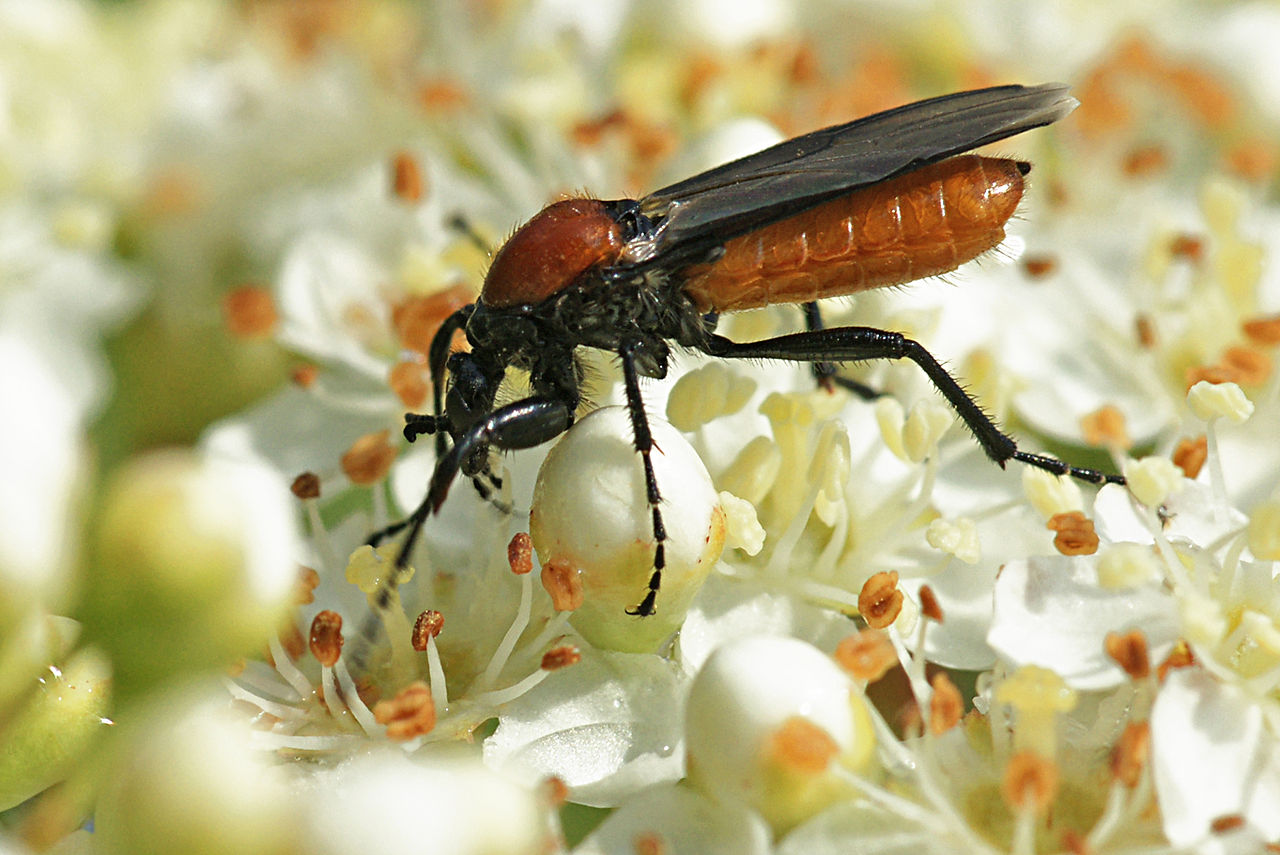
Bibionid fly adults Dilophus febrilis Female St Mark’s fly Bibio marci
Life cycle
Most bibionid flies emerge and lay eggs in the soil during the spring but some species have a second generation with adults also appearing in late summer-early autumn. The larvae live and feed in the surface layers of the soil and overwinter as late instar larvae. Pupation takes place in the soil a few weeks before the adult emergence period in late spring.
Role of bibionid flies in gardens
Bibionid larvae largely feed on decomposing plant material and are useful recyclers. They will occasionally feed on plant roots and have been recorded as pests although it is uncommon for them to cause damage in gardens. In years when there is a mass emergence of adult bibionid flies, this can cause concern but the adults are short lived, so any nuisance soon goes away. Bibionid flies are active at a time when fruit trees and bushes are in flowers, so they are likely to be assisting with pollination when they visit flowers. The slow-flying flies are an easy meal for birds such as house martins, swallows and swifts.
Other sources of information
Website
Steve Falk’s images and information on bibionid flies
Books
Freeman, P. & Lane, R. P. (1985) Handbooks for the Identification of British Insects Vol 9, part 7 Bibionid and Scatopsid flies. Royal Entomological Society
Page text drafted by Andrew Halstead, reviewed by Andrew Salisbury, compiled by Steve Head
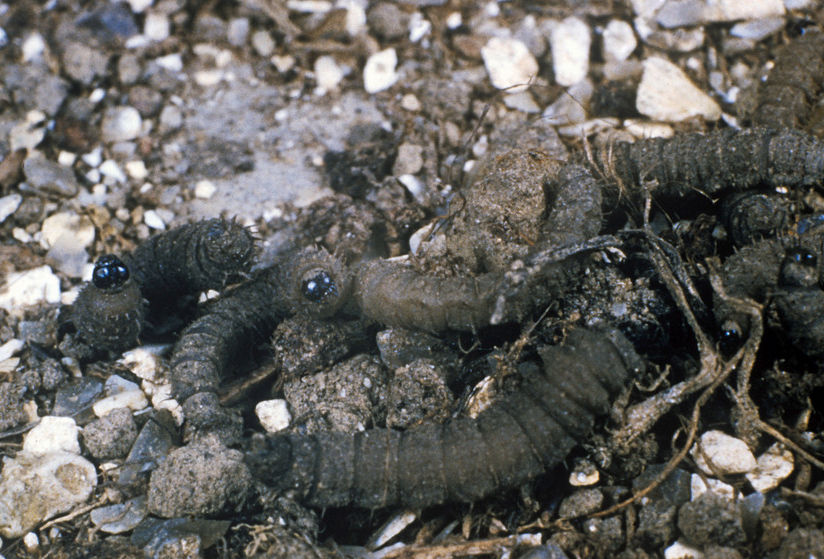
Group of bibionid larvae. They resemble the leatherjacket larvae of crane flies but have a hard tough head cuticle showing black in this picture.
Bibionid flies
Flies in the family Bibionidae, sometimes called March flies, are mainly seen in late spring and are often associated with lawns and other grassy places.
Species in Britain and Ireland
There are 18 species of bibionid flies in Britain and Ireland, in two genera, with 14 Bibio species and four Dilophus species. The latter are 5-6 mm long as adults and are sometimes called fever flies. Dilophus febrilis is a very common species. Most Bibio species lack common names, but Bibio marci is known as St Mark’s fly, because ite annual emergence tends to conicide with St Mark's Day on 25th April. This is 10-12mm long and one of the larger species. Most Bibio species are 6-8mm long, including Bibio johannis and B. hortulanus, which are associated with lawns.


Bibionid fly adults Dilophus febrilis Female St Mark’s fly Bibio marci


Male St Mark’s fly Bibio marci in flight, showing typical dangling legs. Right: Bibio hortulanus female
Biology
Bibionid flies are mainly black in colour but sometimes have reddish brown legs or abdomens. The males have particularly large eyes that cover most of the head. The hind legs are longer than the other two pairs and dangle down when the insect is in flight. They fly relatively slowly and male St Marc's fly sometimes appear in mating swarms in grassy places on sunny days in April-May.
The adult flies often visit flowers where they presumably feed on nectar and pollen. The larvae live near the soil surface where they feed on plant roots and decaying plant material. Sometimes large aggregations of the greyish brown larvae are found when accumulations of dead leaves are being raked up in the autumn. Bibionid larvae are superficially similar in appearance to leatherjackets, which are the larvae of crane flies. Unlike leatherjackets, bibionid larvae have distinct head capsules and small spines projecting from the body segments.
Group of bibionid larvae. They resemble the leatherjacket larvae of crane flies but have a hard tough head cuticle showing black in this picture.

Life cycle
Most bibionid flies emerge and lay eggs in the soil during the spring but some species have a second generation with adults also appearing in late summer-early autumn. The larvae live and feed in the surface layers of the soil and overwinter as late instar larvae. Pupation takes place in the soil a few weeks before the adult emergence period in late spring.
Role of bibionid flies in gardens
Bibionid larvae largely feed on decomposing plant material and are useful recyclers. They will occasionally feed on plant roots and have been recorded as pests although it is uncommon for them to cause damage in gardens. In years when there is a mass emergence of adult bibionid flies, this can cause concern but the adults are short lived, so any nuisance soon goes away. Bibionid flies are active at a time when fruit trees and bushes are in flowers, so they are likely to be assisting with pollination when they visit flowers. The slow-flying flies are an easy meal for birds such as house martins, swallows and swifts.
Other sources of information
Website
Books
Freeman, P. & Lane, R. P. (1985) Handbooks for the Identification of British Insects Vol 9, part 7 Bibionid and Scatopsid flies. Royal Entomological Society
Page text drafted by Andrew Halstead, reviewed by Andrew Salisbury, compiled by Steve Head












